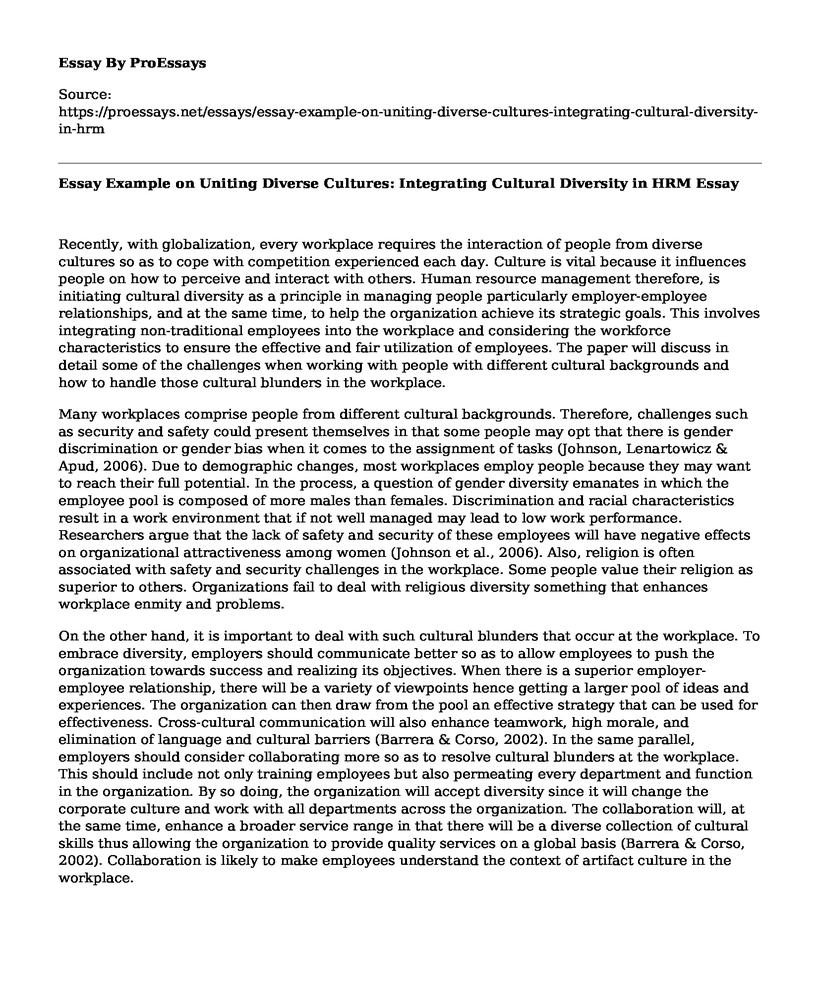Recently, with globalization, every workplace requires the interaction of people from diverse cultures so as to cope with competition experienced each day. Culture is vital because it influences people on how to perceive and interact with others. Human resource management therefore, is initiating cultural diversity as a principle in managing people particularly employer-employee relationships, and at the same time, to help the organization achieve its strategic goals. This involves integrating non-traditional employees into the workplace and considering the workforce characteristics to ensure the effective and fair utilization of employees. The paper will discuss in detail some of the challenges when working with people with different cultural backgrounds and how to handle those cultural blunders in the workplace.
Many workplaces comprise people from different cultural backgrounds. Therefore, challenges such as security and safety could present themselves in that some people may opt that there is gender discrimination or gender bias when it comes to the assignment of tasks (Johnson, Lenartowicz & Apud, 2006). Due to demographic changes, most workplaces employ people because they may want to reach their full potential. In the process, a question of gender diversity emanates in which the employee pool is composed of more males than females. Discrimination and racial characteristics result in a work environment that if not well managed may lead to low work performance. Researchers argue that the lack of safety and security of these employees will have negative effects on organizational attractiveness among women (Johnson et al., 2006). Also, religion is often associated with safety and security challenges in the workplace. Some people value their religion as superior to others. Organizations fail to deal with religious diversity something that enhances workplace enmity and problems.
On the other hand, it is important to deal with such cultural blunders that occur at the workplace. To embrace diversity, employers should communicate better so as to allow employees to push the organization towards success and realizing its objectives. When there is a superior employer-employee relationship, there will be a variety of viewpoints hence getting a larger pool of ideas and experiences. The organization can then draw from the pool an effective strategy that can be used for effectiveness. Cross-cultural communication will also enhance teamwork, high morale, and elimination of language and cultural barriers (Barrera & Corso, 2002). In the same parallel, employers should consider collaborating more so as to resolve cultural blunders at the workplace. This should include not only training employees but also permeating every department and function in the organization. By so doing, the organization will accept diversity since it will change the corporate culture and work with all departments across the organization. The collaboration will, at the same time, enhance a broader service range in that there will be a diverse collection of cultural skills thus allowing the organization to provide quality services on a global basis (Barrera & Corso, 2002). Collaboration is likely to make employees understand the context of artifact culture in the workplace.
Conclusion
In conclusion, despite the challenges that emanate at the workplace, cultural diversity reflects a changing world. Safety and security therefore, can be addressed by respecting individual differences, communicating with employees, and collaborating more. Cultural diversity benefits any organization by increasing competitive edge, augmenting work productivity, and creating a safe and fair environment. Organizations therefore, need to learn the importance of cultural diversity and adopt them so as to be successful.
References
Barrera, I., & Corso, R. M. (2002). Cultural competency as skilled dialogue. Topics in Early Childhood Special Education, 22(2), 103-113.
Johnson, J. P., Lenartowicz, T., & Apud, S. (2006). Cross-cultural competence in international business: Toward a definition and a model. Journal of international business studies, 37(4), 525-543.
Cite this page
Essay Example on Uniting Diverse Cultures: Integrating Cultural Diversity in HRM. (2023, Apr 07). Retrieved from https://proessays.net/essays/essay-example-on-uniting-diverse-cultures-integrating-cultural-diversity-in-hrm
If you are the original author of this essay and no longer wish to have it published on the ProEssays website, please click below to request its removal:
- Postgraduate Dentistry Personal Statement
- Letters About Business Problems With Employees
- Essay Sample on Rights and Responsibilities of Employees
- Essay Sample on Conflict: Police vs City Management
- Essay Example on Police Officers: Essential Characteristics for Quality Service Delivery
- Maximizing Performance: The Role of HR & Comm. in Hospital Settings - Essay Sample
- Essay Sample on Conflict Theory: Karl Marx's Perspective on Social Order







